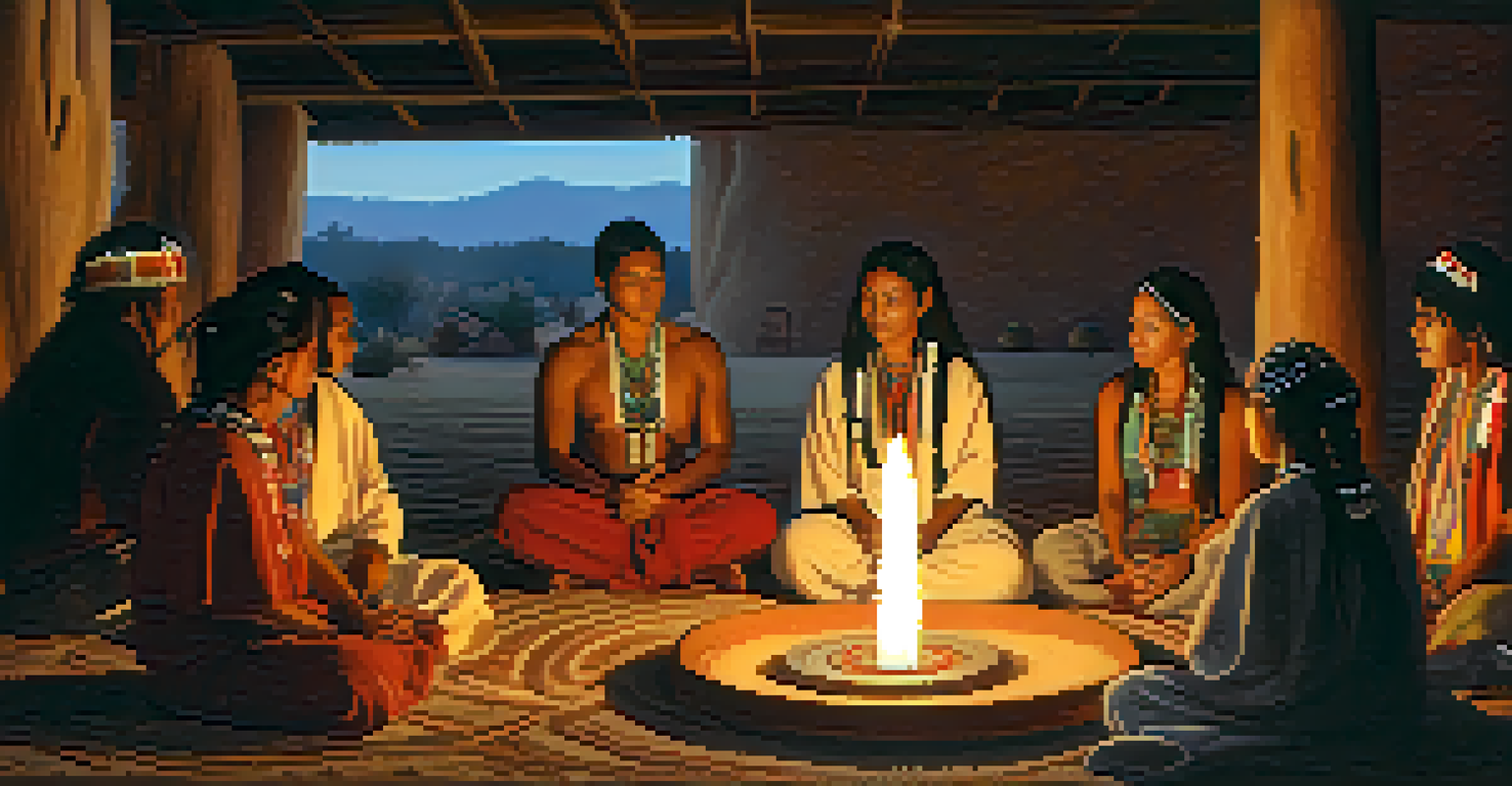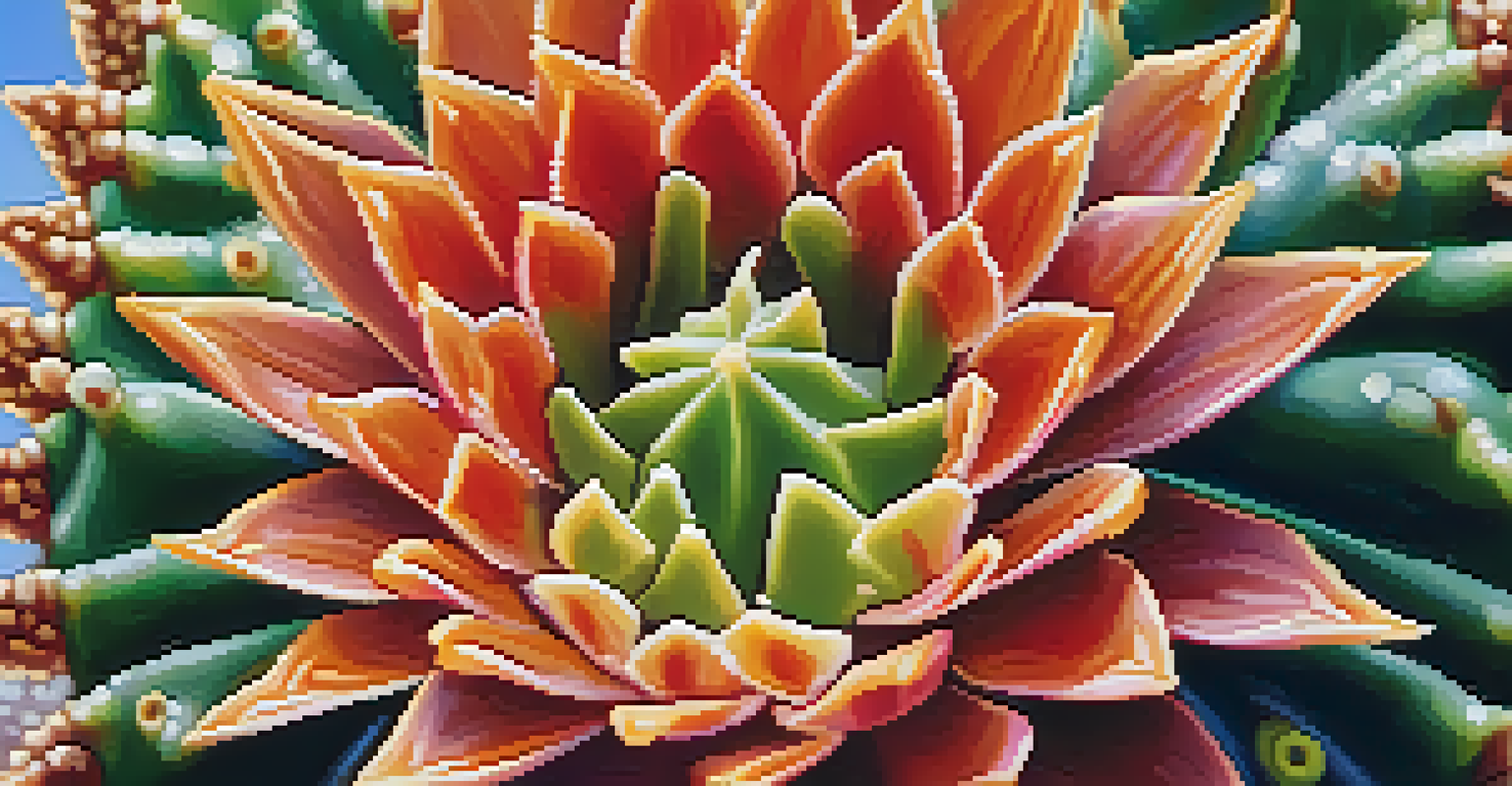The Intersection of Peyote Use and Cultural Identity

Understanding Peyote: A Cultural and Spiritual Symbol
Peyote, a small cactus native to Mexico and the southwestern United States, has been used for thousands of years in various indigenous cultures. It contains mescaline, a psychoactive compound that induces altered states of consciousness, often used in spiritual and religious contexts. For many Native American tribes, peyote is not just a plant but a significant symbol of identity and cultural heritage.
The use of peyote illustrates the intersection of spirituality and cultural identity, emphasizing how traditional practices shape personal and communal experiences.
In these communities, peyote ceremonies serve as a means of connecting with ancestors, healing, and exploring one's inner self. The ritualistic use of peyote is steeped in tradition, providing a framework for understanding the spiritual world. This deep-rooted connection makes peyote an essential part of cultural identity for many indigenous peoples.
The use of peyote illustrates the intersection of spirituality and cultural identity, emphasizing how traditional practices shape personal and communal experiences. As more people learn about peyote, its significance within these cultures becomes increasingly acknowledged and respected.
Historical Context of Peyote Use in Indigenous Cultures
The history of peyote use dates back to ancient Mesoamerican civilizations, where it was revered for its psychoactive properties. Indigenous groups, such as the Huichol and the Navajo, have long incorporated peyote into their spiritual practices, believing it facilitates communication with the divine. This historical context is crucial for understanding the cultural significance of peyote today.

Throughout the 19th and 20th centuries, peyote's use began to face scrutiny and legal challenges, especially with the rise of anti-drug policies. However, many Native American tribes fought to preserve their right to use peyote in religious ceremonies, arguing that it is central to their cultural identity. The legal battles highlight the ongoing struggle to maintain traditional practices in the face of modern societal pressures.
Peyote's Cultural Significance
Peyote serves as a vital symbol of identity and spiritual connection for many indigenous cultures.
Today, the historical context surrounding peyote use serves as a reminder of the resilience of indigenous cultures. The ongoing commitment to preserving these traditions is a testament to their importance in shaping personal and collective identities.
Peyote and the Native American Church: A Unique Relationship
The Native American Church (NAC) plays a pivotal role in the contemporary use of peyote, acting as a unifying force for many indigenous peoples. Founded in the early 20th century, the NAC integrates traditional beliefs with elements of Christianity, creating a unique spiritual framework. Peyote ceremonies are central to this faith, emphasizing healing, community, and spiritual growth.
Understanding the legal landscape surrounding peyote is crucial for appreciating the broader context of cultural rights.
For NAC members, peyote is considered a sacrament, providing a pathway to connect with the Creator and promote personal well-being. The ceremonies often involve singing, drumming, and sharing stories, fostering a strong sense of community and belonging. This communal aspect reinforces the idea that cultural identity is not merely personal; it’s deeply intertwined with collective experiences.
The relationship between peyote and the NAC illustrates how cultural identity can evolve while retaining core spiritual beliefs. It highlights the adaptability of indigenous practices in a changing world, showcasing the ongoing relevance of peyote in contemporary society.
Cultural Identity and Modern Challenges: A Balancing Act
As society becomes more aware of peyote's cultural significance, many indigenous groups face challenges in preserving their traditions. Issues like cultural appropriation and commercialization of peyote have sparked debates about who has the right to use this sacred plant. These modern challenges threaten the authenticity of traditional practices and raise questions about cultural identity.
Indigenous voices have become increasingly important in these discussions, advocating for the protection of their cultural heritage. Many emphasize the need for respectful engagement with peyote, highlighting the difference between spiritual use and commodification. This call for respect is a vital part of safeguarding cultural identity in the face of external pressures.
Legal Challenges for Peyote Use
The legal landscape surrounding peyote highlights ongoing struggles for indigenous rights and the preservation of cultural practices.
Navigating these challenges requires a delicate balance between embracing modernity and honoring tradition. The ongoing dialogue about peyote use reflects broader issues of cultural preservation and identity within indigenous communities.
Personal Testimonials: The Impact of Peyote on Identity
Personal stories from individuals who have participated in peyote ceremonies offer profound insights into its impact on cultural identity. Many describe experiences of profound healing, connection to their ancestors, and a deeper understanding of their place within their communities. These testimonials highlight how peyote serves as a catalyst for personal transformation and cultural reaffirmation.
For some, the experience of using peyote in a ceremonial context has led to a renewed sense of pride in their heritage. They often share how these experiences have helped them navigate the complexities of modern life while staying rooted in their cultural identity. The transformative power of peyote is evident in their stories, revealing its role in fostering resilience and connection.
These personal narratives underscore the importance of respecting and understanding the cultural significance of peyote. They serve as reminders that behind every tradition are real people whose lives are deeply intertwined with their cultural practices.
Legal Landscape: Peyote Use and Cultural Rights
The legal status of peyote in the United States is a complex issue, often tied to the broader conversation about indigenous rights. While the American Indian Religious Freedom Act allows for the use of peyote in religious ceremonies, legal challenges and restrictions still exist. This legal landscape raises important questions about the intersection of cultural practices and government regulations.
Many indigenous groups advocate for clearer protections surrounding peyote use, emphasizing its role in cultural identity and spiritual practices. The ongoing legal battles highlight the importance of recognizing indigenous sovereignty and the right to practice traditional customs without interference. Advocacy efforts aim to ensure that peyote remains available for those who rely on it for cultural and spiritual fulfillment.
Impact on Personal Identity
Personal testimonials reveal how peyote ceremonies facilitate profound healing and reaffirm cultural identity among participants.
Understanding the legal landscape surrounding peyote is crucial for appreciating the broader context of cultural rights. It emphasizes the need for dialogue and collaboration between indigenous communities and policymakers to safeguard these vital traditions.
The Future of Peyote Use and Cultural Identity
Looking ahead, the future of peyote use and its role in cultural identity remains uncertain yet hopeful. As interest in indigenous practices grows, there is potential for greater understanding and respect for the significance of peyote. This shift could lead to more inclusive conversations about cultural identity and the importance of preserving traditional practices.
However, challenges such as environmental concerns regarding peyote cultivation and sustainability must also be addressed. As demand for peyote increases, it is essential to ensure that its use remains respectful and sustainable, honoring the plant's sacred status. Balancing these concerns with the desire for cultural preservation will be key in the coming years.

Ultimately, the intersection of peyote use and cultural identity will continue to evolve. Ongoing dialogue and education will be vital in fostering respect for these traditions, ensuring that they remain vibrant and relevant for future generations.